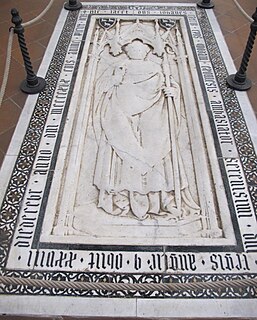Related Research Articles
Simon de Langham was an English clergyman who was Archbishop of Canterbury and a cardinal.

William Melton was the 43rd Archbishop of York (1317–1340).
Marmaduke Lumley was an English priest, Bishop of Carlisle from 1429 to 1450, and Knight Commander of the Order of St. John of Jerusalem. He was a son of Ralph de Lumley, 1st Baron Lumley and Eleanor de Neville. He was elected about 5 December 1429, and consecrated on 16 April 1430. He was Bishop of Lincoln for a short time before his death in December 1450. He was educated at University of Cambridge and was appointed Precentor of Lincoln Cathedral in 1425. He also became Chancellor of the University of Cambridge in 1427 and was Master of Trinity Hall, Cambridge from 1429 to 1443. From 1446 to 1449 he served as Lord High Treasurer of England. Lumley's tenure as Lord High Treasurer occurred during the Great Bullion Famine and the Great Slump in England.
John Fordham was Bishop of Durham and Bishop of Ely.
Thomas Cobham was an English churchman, who was Archbishop-elect of Canterbury in 1313 and later Bishop of Worcester from 1317 to 1327.
Adam Orleton was an English churchman and royal administrator.

John Barnet was a Bishop of Worcester then Bishop of Bath and Wells then finally Bishop of Ely.
Nicholas Bubwith (1355-1424) was a Bishop of London, Bishop of Salisbury and Bishop of Bath and Wells as well as Lord Privy Seal and Lord High Treasurer of England.
Thomas Polton was a medieval Bishop of Hereford, Bishop of Chichester, and Bishop of Worcester.

John Catterick was a medieval Bishop of St David's, Bishop of Coventry and Lichfield, and Bishop of Exeter.

John Hotham was a medieval Chancellor of the Exchequer, Lord High Treasurer, Lord Chancellor and Bishop of Ely.

Richard Redman was a medieval Premonstratensian canon and abbot of Shap Abbey, Bishop of St Asaph, Bishop of Exeter, and Bishop of Ely, as well as the commissary-general for the Abbot of Prémontré between 1459 and his death.
John Gilbert was a medieval Bishop of Bangor, Bishop of Hereford and Bishop of St. David's.
Richard de Wentworth was a medieval Bishop of London.
William Middleton was a medieval Bishop of Norwich.
Thomas Wouldham was a medieval Bishop of Rochester.

Hamo Hethe was a medieval Bishop of Rochester, England. He was born about 1275 in Centuries, Hythe. He was elected on 18 March 1317 and consecrated on 26 August 1319. He resigned the see early 1352 before his death 4 May 1352.
Eadmund was a 9th-century Englishman. It had been thought he had been Bishop of Winchester between 833 and 838. However, following further studies he is no longer listed to have been bishop.
Walter Maidstone was a medieval Bishop of Worcester. He was nominated on 1 October 1313 and consecrated on 7 October 1313. He died on 28 March 1317.
Joseph Walsh (1888–1972) was an Irish clergyman of the Roman Catholic Church. He served as Archbishop of Tuam from 1940 to 1969.
References
- Fryde, E. B.; Greenway, D. E.; Porter, S.; Roy, I. (1996). Handbook of British Chronology (Third revised ed.). Cambridge: Cambridge University Press. ISBN 0-521-56350-X.
| Catholic Church titles | ||
|---|---|---|
| Preceded by Gilbert Segrave | Bishop of London 1316–1317 | Succeeded by Stephen Gravesend |
| | This article about an English bishop or archbishop is a stub. You can help Wikipedia by expanding it. |
